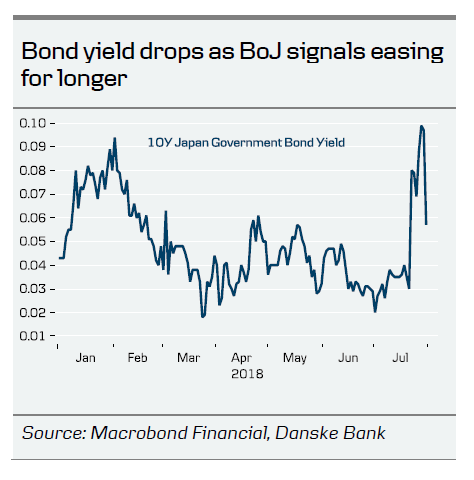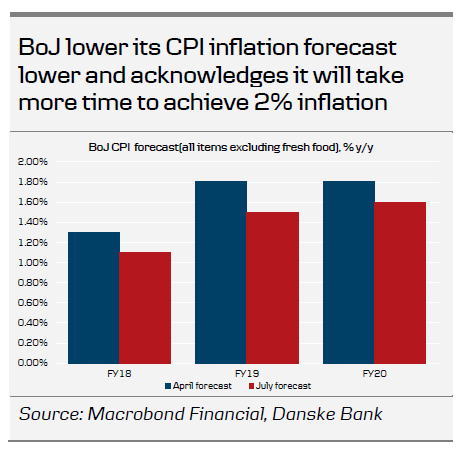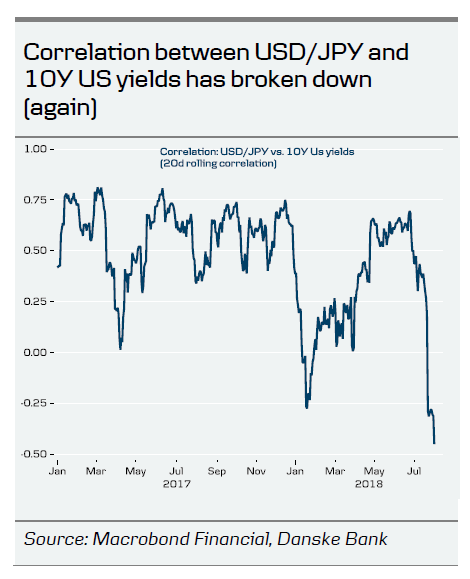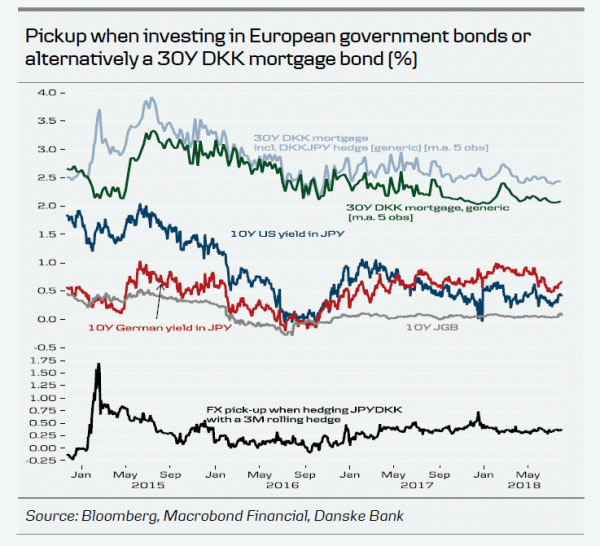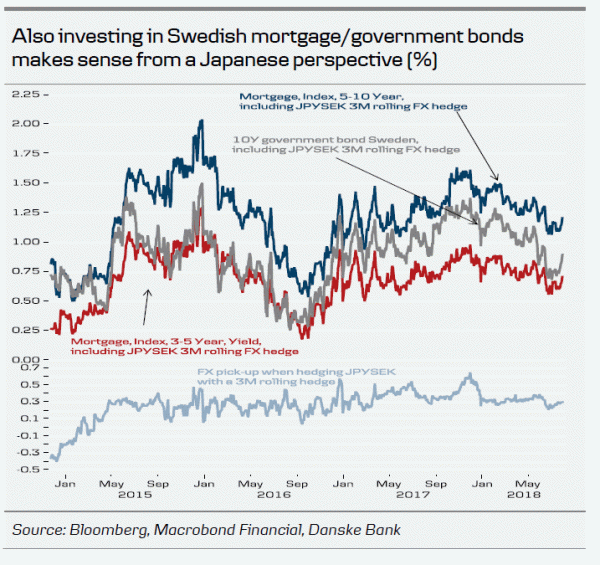- The Bank of Japan has tweaked its policy and introduced forward guidance in order to increase policy sustainability, as the weaker inflation outlook requires easing for longer.
- The effective upper bound on 10Y Japanese government bonds has been lifted to 0.2% from 0.1% previously, as the BoJ will now allow yields to fluctuate 20bp around the 0% target – a doubling from the previous tolerance of 10bp.
- We expect the BoJ to keep its current policy intact until the end of 2019 at least.
- We see today’s announcement as positive for global fixed income markets and, if anything, the new forward guidance could accelerate inflows into Europe.
- The BoJ’s monetary policy should still be supportive for USD/JPY longer term. We target 112 in 1-3M and 114 in 6-12M.
Tweaks and forward guidance as policy sustainability is crucial
This morning, the BoJ announced a series of adjustments to its current monetary policy. Most importantly, while it kept its policy balance rate unchanged at -0.1% and the 10Y bond yield target unchanged at 0%, the BoJ will now allow more flexibility in yields going forward.
At the press conference, BoJ Governor Haruhiko Kuroda explicitly said that this means the BoJ will now allow yields on 10Y Japanese government bonds (JGB) to fluctuate 20bp around the 0% target – a doubling from the previous tolerance of 10bp. Hence, the effective upper bound for 10Y yields has been lifted to 0.2% from 0.1% previously. In relation to the higher tolerance for volatility in yields, the BoJ added that ‘yields may move upward and downward to some extent, mainly depending on developments in economic activity and prices’. Hence, as long as the Japanese economy continues to expand and the output gap remains negative, the average trading range in 10Y Japanese yields is expected to increase modestly going forward, allowing the yield curve to steepen.
In addition, the BoJ also introduced forward guidance and now intends to maintain the current extremely low levels of short- and long-term interest rates for an extended period of time. The BoJ said it decided to introduce forward guidance in order to strengthen its commitment to achieve 2% inflation.
We expect the BoJ to maintain current policy until end-2019
In the Outlook Report, the BoJ made substantial downward revisions to its inflation forecast and it now acknowledges it will take more time to achieve 2% inflation. Hence, today’s tweaks should be viewed as adjustments aiming to keep the BoJ’s ultra-loose policy intact for as long as possible by improving the sustainability of the policy framework. Previously, we called for a 10bp hike in the 10Y yield target around summer 2019, but given the adjustments today, and not least the allowance for more yield volatility, we now expect the BoJ to keep its current policy intact until the end of 2019 at least
FX outlook: BoJ-Fed divergence still supports a higher USD/JPY
In our view, today’s adjustments in the BoJ’s monetary policy should remain supportive for USD/JPY in the longer term. On the one side, slightly higher Japanese yields and higher interest rates volatility are negative for USD/JPY. On the other hand, the adjustments have, in our view, improved the credibility of the BoJ’s policy, which is positive for USD/JPY. While the correlation between USD/JPY and 10Y US yields has collapsed recently, we believe global fixed markets are likely to remain a key driver for the yen going forward. However, the prospect of higher volatility in the JGB market means that the relationship between USD/JPY and 10Y US yield might be slightly weaker in the future. Taking FX positioning and the overall fragile risk environment into consideration, we see little potential for a sustained rally in USD/JPY above July’s high at 113.17 in the near term. We target 112 in 1-3M. Longer term, we still expect USD/JPY to remain underpinned by relative interest rates and continued global growth, targeting 114 in 6-12M.
Japanese investors will continue to invest in European bonds
We see today’s announcement from the BoJ as positive for global fixed income markets. Despite the range for 10Y JGB yields having now been widened to 0.2% either way from previously 0.1%, the outlook is now for relatively stable JGB yields for a prolonged period. The Japanese yield control has forced Japanese fixed income investors abroad to get a higher yield. Especially Europe has benefited over the past two years as Japanese investors have returned after the European debt crisis deterred investors in preceding years. Importantly, the flattening of the US curve and the ‘steep’ European curve have pushed Japanese investors towards Europe. The reason is that many Japanese investors hedge the currency exposure rolling short-dated FX forwards. It has become increasingly expensive to hedge USD exposure, whereas EUR, SEK, DKK currency exposure actually offer a small positive pickup given the negative short rates and currency basis in these currencies. Importantly, there was no signs today that the BoJ has any plans to lower policy rates further, which would potentially erode the FX pickup.
In our view, today’s news is not expected to change the flow into Europe, if anything the new forward guidance could accelerate the inflows. The graphs below show the effective yield a Japanese investor receives when investing currency hedged in 10Y Germany, 10Y US, 30Y DKK mortgage bonds and Swedish government and mortgage bonds.




